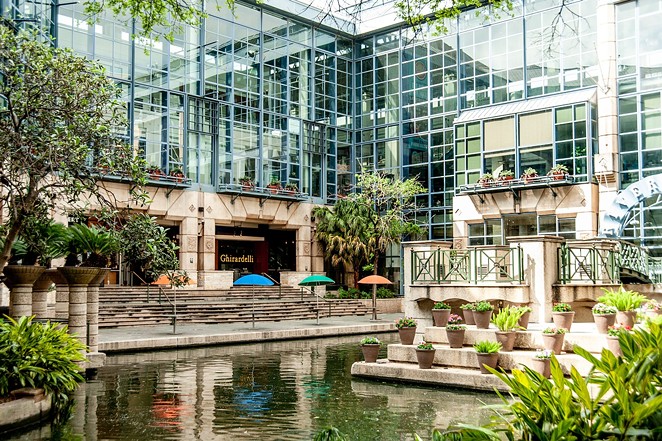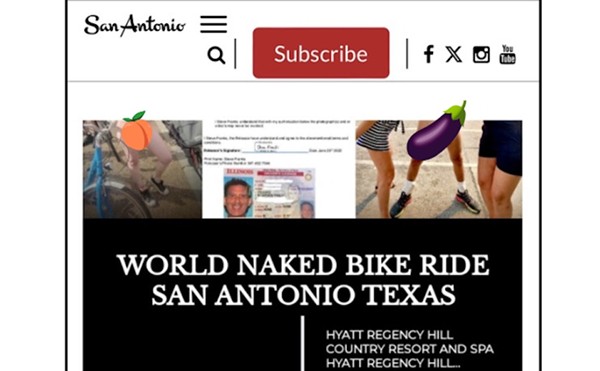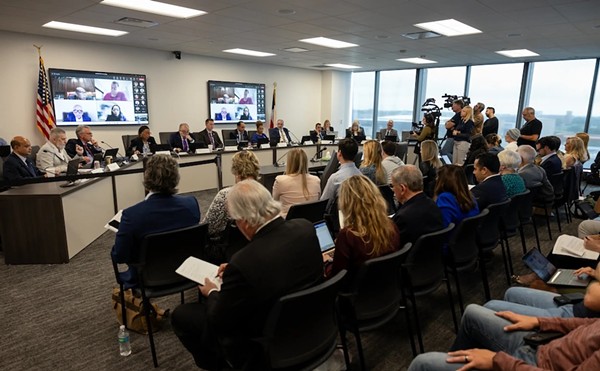During the tourism slump, San Antonio should kick its addiction to incentivizing downtown hotels
By Heywood Sanders on Wed, Jan 27, 2021 at 9:10 am
Editor’s Note: The following is CityScrapes, a column of opinion and analysis.
San Antonio stands at a crossroads.
The coronavirus pandemic has devastated our economy and caused enormous social and economic pain for our citizens. That pain has been greatest for those who work in the visitor and hospitality sectors. The convention business has collapsed, travel has shrunk, and restaurants have shuttered. It will be years before those jobs return, if ever. That economic devastation has been most pronounced in the part of our city most reliant on visitors and hotel stays — the downtown core.
Over a period of some five decades, we — or rather, our political and business leadership — succeeded in building a downtown that functions almost solely for visitors. In 2011, HR&A Advisors, commissioned to produce a Center City Strategic Framework Plan, concluded that “downtown has experienced an imbalance of uses: hotels and visitor-centric retail are now the dominant businesses, not only in the immediate core of downtown, but also along many of the area’s major corridors.” And when planner and educator Alexander Garvin (author of The American City: What Works, What Doesn’t and Public Parks: Key to Livable Communities) visited to speak at UTSA’s Downtown Campus, he observed “your downtown is nothing but hotels.”
Our “nothing but hotels” downtown didn’t happen by accident, or purely by market forces. It was built by decades of public plans and subsidies, justified by great piles of outside consultant studies and city staff recommendations. It was just a few years after the conclusion of HemisFair ’68 that the Greater San Antonio Chamber of Commerce commissioned a consultant study of a new hotel project for the Alamo Plaza area. The 1973 Laventhol, Kreckstein Horwath & Horwath report concluded that a new 1,000-room hotel was feasible for San Antonio, enabling the city to “attract national conventions that have been turned away due to lack of accommodations.”
We didn’t get that 1,000-room hotel then. But the argument that a big, new hotel was key to unlocking unheard-of convention business helped induce B. K. Johnson and others to invest in the new Hyatt Regency — well, more accurately, that argument and $6.5 million in federal government dollars.
The Hyatt was just the first in what became a parade of public subsidy deals for downtown hotels. Federal Urban Development Action Grant dollars in the 1990s also subsidized Rivercenter Mall, the Marriott Rivercenter and the Emily Morgan Hotel. Then city property tax abatements kicked in, and we extended abatement deals for the Adam’s Mark/Crowne Plaza/Wyndham in the 1990s, along with similar incentives for the Hyatt Hill Country near Sea World and the La Cantera Resort hotel.
After a decade-long quest for a second 1,000-room hotel flopped, the city used federal empowerment zone bonds to build downtown’s Grand Hyatt, putting taxpayers on the hook to pay off the debt. There was also another empowerment zone bond deal for the Drury Plaza downtown. Then, to make sure we had the conventioneers to fill those big hotels, we needed to expand the convention center — first in 2000, and more recently in 2016.
Every hotel subsidy deal, each of the convention center expansions, was justified by a city staff recommendation, bolstered by multiple bulky consultant studies from the likes of PKF, CSL, and HVS — all of which uniformly told us that more hotel rooms or a bigger convention center would create more business, jobs and “economic impact.”
San Antonio’s hospitality industry now faces a “bleak winter” for the next three or four years, at the very least. There is no way to market our way out of it. No boost in advertising dollars will work. No blue-ribbon advisory board of local notables will deal with our job losses. (For more on San Antonio's trouble hospitality sector, read this issue's cover story.)
Now is the time to deal with reality. The city’s policymaking process has long been flawed, with staff reports and consultant studies that told us exactly the same thing every other city was told. So, when we invested in a big new hotel, so too did Austin, Dallas, Houston and Fort Worth. And when we expanded our convention center, those same cities, and more, did the same. We need to reconsider our downtown, with the aim of developing its functions and activity centers to attract and serve San Antonians rather than visitors, building a more inclusive city. And we need to assure that those once employed in downtown hotels and restaurants have the first opportunity to learn new skills that can broaden their futures.
When city council set up those previous advisory boards, they were invariably filled with hospitality-sector insiders and the same group of business leaders. We need a far more inclusive process for examining the future of our downtown and our visitor orientation, a process that puts those who depend on hotels and restaurants for a wage at the forefront. An NFL team won’t secure our economic future. We need a reshaped economy to do that — replanned by all who live and work here.
Heywood Sanders is a professor of public policy at the University of Texas at San Antonio.
Stay on top of San Antonio news and views. Sign up for our Weekly Headlines Newsletter.
San Antonio stands at a crossroads.
The coronavirus pandemic has devastated our economy and caused enormous social and economic pain for our citizens. That pain has been greatest for those who work in the visitor and hospitality sectors. The convention business has collapsed, travel has shrunk, and restaurants have shuttered. It will be years before those jobs return, if ever. That economic devastation has been most pronounced in the part of our city most reliant on visitors and hotel stays — the downtown core.
Over a period of some five decades, we — or rather, our political and business leadership — succeeded in building a downtown that functions almost solely for visitors. In 2011, HR&A Advisors, commissioned to produce a Center City Strategic Framework Plan, concluded that “downtown has experienced an imbalance of uses: hotels and visitor-centric retail are now the dominant businesses, not only in the immediate core of downtown, but also along many of the area’s major corridors.” And when planner and educator Alexander Garvin (author of The American City: What Works, What Doesn’t and Public Parks: Key to Livable Communities) visited to speak at UTSA’s Downtown Campus, he observed “your downtown is nothing but hotels.”
Our “nothing but hotels” downtown didn’t happen by accident, or purely by market forces. It was built by decades of public plans and subsidies, justified by great piles of outside consultant studies and city staff recommendations. It was just a few years after the conclusion of HemisFair ’68 that the Greater San Antonio Chamber of Commerce commissioned a consultant study of a new hotel project for the Alamo Plaza area. The 1973 Laventhol, Kreckstein Horwath & Horwath report concluded that a new 1,000-room hotel was feasible for San Antonio, enabling the city to “attract national conventions that have been turned away due to lack of accommodations.”
We didn’t get that 1,000-room hotel then. But the argument that a big, new hotel was key to unlocking unheard-of convention business helped induce B. K. Johnson and others to invest in the new Hyatt Regency — well, more accurately, that argument and $6.5 million in federal government dollars.
The Hyatt was just the first in what became a parade of public subsidy deals for downtown hotels. Federal Urban Development Action Grant dollars in the 1990s also subsidized Rivercenter Mall, the Marriott Rivercenter and the Emily Morgan Hotel. Then city property tax abatements kicked in, and we extended abatement deals for the Adam’s Mark/Crowne Plaza/Wyndham in the 1990s, along with similar incentives for the Hyatt Hill Country near Sea World and the La Cantera Resort hotel.
After a decade-long quest for a second 1,000-room hotel flopped, the city used federal empowerment zone bonds to build downtown’s Grand Hyatt, putting taxpayers on the hook to pay off the debt. There was also another empowerment zone bond deal for the Drury Plaza downtown. Then, to make sure we had the conventioneers to fill those big hotels, we needed to expand the convention center — first in 2000, and more recently in 2016.
Every hotel subsidy deal, each of the convention center expansions, was justified by a city staff recommendation, bolstered by multiple bulky consultant studies from the likes of PKF, CSL, and HVS — all of which uniformly told us that more hotel rooms or a bigger convention center would create more business, jobs and “economic impact.”
San Antonio’s hospitality industry now faces a “bleak winter” for the next three or four years, at the very least. There is no way to market our way out of it. No boost in advertising dollars will work. No blue-ribbon advisory board of local notables will deal with our job losses. (For more on San Antonio's trouble hospitality sector, read this issue's cover story.)
Now is the time to deal with reality. The city’s policymaking process has long been flawed, with staff reports and consultant studies that told us exactly the same thing every other city was told. So, when we invested in a big new hotel, so too did Austin, Dallas, Houston and Fort Worth. And when we expanded our convention center, those same cities, and more, did the same. We need to reconsider our downtown, with the aim of developing its functions and activity centers to attract and serve San Antonians rather than visitors, building a more inclusive city. And we need to assure that those once employed in downtown hotels and restaurants have the first opportunity to learn new skills that can broaden their futures.
When city council set up those previous advisory boards, they were invariably filled with hospitality-sector insiders and the same group of business leaders. We need a far more inclusive process for examining the future of our downtown and our visitor orientation, a process that puts those who depend on hotels and restaurants for a wage at the forefront. An NFL team won’t secure our economic future. We need a reshaped economy to do that — replanned by all who live and work here.
Heywood Sanders is a professor of public policy at the University of Texas at San Antonio.
Stay on top of San Antonio news and views. Sign up for our Weekly Headlines Newsletter.

KEEP SA CURRENT!
Since 1986, the SA Current has served as the free, independent voice of San Antonio, and we want to keep it that way.
Becoming an SA Current Supporter for as little as $5 a month allows us to continue offering readers access to our coverage of local news, food, nightlife, events, and culture with no paywalls.
Scroll to read more San Antonio News articles
Newsletters
Join SA Current Newsletters
Subscribe now to get the latest news delivered right to your inbox.

















